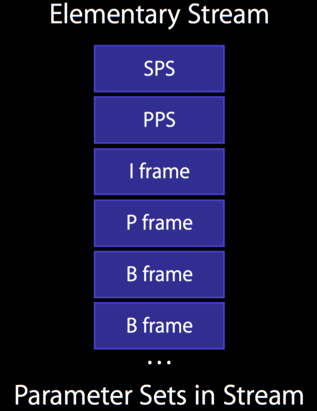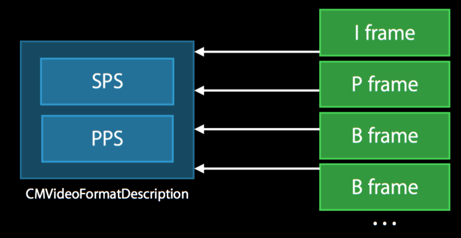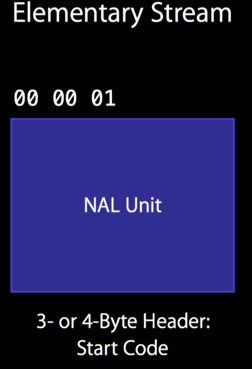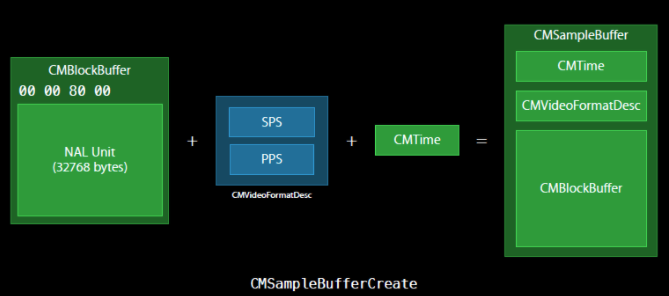——————————————————–
本例需求:使用H264, H265实现视频数据的编码并录制开始200帧存为文件.
原理:比如做直播功能,需要将客户端的视频数据传给服务器,如果分辨率过大如2K,4K则传输压力太大,所以需要对视频数据进行编码,传给服务器后再解码以实现大数据量的视频数据的传输,而利用硬件编码则可以极大限度减小CPU压力,当前主流使用H264进行编码,iOS 11 之后,iPhone 7以上的设备可以支持新的编码器H265编码器,使得同等质量视频占用的存储空间更小。所以本例中可以使用两种方式实现视频数据的编码
——————————————————–
最终效果如下 : h264
h265 :
——————————————————–
GitHub地址(附代码) : H264,H265Encode
简书地址 : H264,H265Encode
博客地址 : H264,H265Encode
掘金地址 : https://juejin.im/post/5a8fe3def265da4e8e78781b
——————————————————–
实现方式:
1. H264 : H264是当前主流编码标准,以高压缩高质量和支持多种网络的流媒体传输著称
2. H265 :H264编码器的下一代,它的主要优点提供的压缩比高,相同质量的视频是H264的两倍。
——————————————————–
一.本文需要基本知识点
注意:可以先通过H264,H265编码器介绍,H264 Data Structure了解预备知识。
1. 软编与硬编概念
- 软编码:使用CPU进行编码。
- 硬编码:不使用CPU进行编码,使用显卡GPU,专用的DSP、FPGA、ASIC芯片等硬件进行编码。
- 比较
- 软编码:实现直接、简单,参数调整方便,升级易,但CPU负载重,性能较硬编码低,低码率下质量通常比硬编码要好一点。
- 性能高,低码率下通常质量低于软编码器,但部分产品在GPU硬件平台移植了优秀的软编码算法(如X264)的,质量基本等同于软编码。
- 苹果在iOS 8.0系统之前,没有开放系统的硬件编码解码功能,不过Mac OS系统一直有,被称为Video ToolBox的框架来处理硬件的编码和解码,终于在iOS 8.0后,苹果将该框架引入iOS系统
- 比较
2.H265优点
- 压缩比高,在相同图片质量情况下,比JPEG高两倍
- 能增加如图片的深度信息,透明通道等辅助图片。
- 支持存放多张图片,类似相册和集合。(实现多重曝光的效果)
- 支持多张图片实现GIF和livePhoto的动画效果。
- 无类似JPEG的最大像素限制
- 支持透明像素
- 分块加载机制
- 支持缩略图
二.代码解析
1.实现流程
- 初始化相机参数,设置相机代理,这里就固定只有竖屏模式。
- 初始化编码器参数,并启动编码器
- 在编码成功的回调中从开始录制200帧(文件大小可自行修改)的视频,存到沙盒中,可以通过连接数据线到电脑从itunes中将文件(test0.asf)提取出来
2.编码器实现流程
- 创建编码器需要的session (h264, h265 或同时创建)
- 设置session属性,如实时编码,码率,fps, 编码的分辨率的宽高,相邻I帧的最大间隔等等
- 当相机回调AVCaptureVideoDataOutputSampleBufferDelegate采集到一帧数据的时候则使用H264/H265编码器对每一帧数据进行编码。
- 若编码成功会触发回调,回调函数首先检测是否有I帧出现,如果有I帧出现则将sps,pps信息写入否则遍历NALU码流并将startCode替换成{0x00, 0x00, 0x00, 0x01}
3.主要方法解析
- 初始化编码器
首先选择使用哪种方式实现,在本例中可以设置[XDXHardwareEncoder getInstance].enableH264 = YES 或者 [XDXHardwareEncoder getInstance].enableH265 = YES,也可以同时设置,如果同时设置需要将其中一个回调函数中的writeFile的方法屏蔽掉,并且只有较新的iPhone(> iPhone8 稳定)才支持同时打开两个session。
判断当前设备是否支持H265编码,必须满足两个条件,一是iPhone 7 以上设备,二是版本大于iOS 11
1 | if (@available(iOS 11.0, *)) { |
系统已经提供VTIsHardwareDecodeSupported判断当前设备是否支持H265编码
初始化编码器操作
1 | - (void)prepareForEncode { |
1> g_isSupportRealTimeEncoder = (is64Bit == 8) ? true : false;用来判断当前设备是32位还是64位
2> 创建H264/H265Session 区别仅仅为参数的不同,h264为kCMVideoCodecType_H264。 h265为kCMVideoCodecType_HEVC,在创建Session指定了回调函数后,当编码成功一帧就会调用相应的回调函数。
3> 通过[self getSupportedPropertyFlags];获取当前编码器支持设置的属性,经过测试,H265不支持码率的限制。目前暂时得不到解决。等待苹果后续处理。
4> 之后设置编码器相关属性,下面会具体介绍,设置完成后则调用VTCompressionSessionPrepareToEncodeFrames准备编码。
- 设置编码器相关属性
1
2
3
4
5
6
7
8
9
10
11
12
13
14
15
16
17
18
19
20
21
22
23
24
25
26
27
28
29
30
31
32
33
34
35
36
37
38
39
40
41
42
43
44
45
46
47
48
49
50
51
52
53
54
55
56
57
58
59
60
61
62
63
64
65
66
67
68
69
70
71
72
73
74
75
76
77
78
79
80
81
82
83
84
85
86
87
88
89- (OSStatus)setSessionProperty:(VTCompressionSessionRef)session key:(CFStringRef)key value:(CFTypeRef)value {
OSStatus status = VTSessionSetProperty(session, key, value);
if (status != noErr) {
NSString *sessionStr;
if (session == h264CompressionSession) {
sessionStr = @"h264 Session";
self.h264ErrCount++;
}else if (session == h265CompressionSession) {
sessionStr = @"h265 Session";
self.h265ErrCount++;
}
NSLog(@"XDXHardwareEncoder : Set %s of %s Failed, status = %d",CFStringGetCStringPtr(key, kCFStringEncodingUTF8),sessionStr.UTF8String,status);
}
return status;
}
- (void)applyAllSessionProperty:(VTCompressionSessionRef)session propertyArr:(NSArray *)propertyArr {
OSStatus status;
if(!g_isSupportRealTimeEncoder) {
/* increase max frame delay from 3 to 6 to reduce encoder pressure*/
int value = 3;
CFNumberRef ref = CFNumberCreate(NULL, kCFNumberSInt32Type, &value);
[self setSessionProperty:session key:kVTCompressionPropertyKey_MaxFrameDelayCount value:ref];
CFRelease(ref);
}
if(self.fps) {
if([self isSupportPropertyWithKey:Key_ExpectedFrameRate inArray:propertyArr]) {
int value = self.fps;
CFNumberRef ref = CFNumberCreate(NULL, kCFNumberSInt32Type, &value);
[self setSessionProperty:session key:kVTCompressionPropertyKey_ExpectedFrameRate value:ref];
CFRelease(ref);
}
}else {
NSLog(@"XDXHardwareEncoder : Current fps is 0");
}
if(self.bitrate) {
if([self isSupportPropertyWithKey:Key_AverageBitRate inArray:propertyArr]) {
int value = self.bitrate;
if (session == h265CompressionSession) value = 2*1000; // if current session is h265, Set birate 2M.
CFNumberRef ref = CFNumberCreate(NULL, kCFNumberSInt32Type, &value);
[self setSessionProperty:session key:kVTCompressionPropertyKey_AverageBitRate value:ref];
CFRelease(ref);
}
}else {
NSLog(@"XDXHardwareEncoder : Current bitrate is 0");
}
/*2016-11-15,@gang, iphone7/7plus do not support realtime encoding, so disable it
otherwize ,we can not control encoding bit rate
*/
if (![[self deviceVersion] isEqualToString:@"iPhone9,1"] && ![[self deviceVersion] isEqualToString:@"iPhone9,2"]) {
if(g_isSupportRealTimeEncoder) {
if([self isSupportPropertyWithKey:Key_RealTime inArray:propertyArr]) {
NSLog(@"use RealTimeEncoder");
NSLog(@"XDXHardwareEncoder : use realTimeEncoder");
[self setSessionProperty:session key:kVTCompressionPropertyKey_RealTime value:kCFBooleanTrue];
}
}
}
if([self isSupportPropertyWithKey:Key_AllowFrameReordering inArray:propertyArr]) {
[self setSessionProperty:session key:kVTCompressionPropertyKey_AllowFrameReordering value:kCFBooleanFalse];
}
if(g_isSupportRealTimeEncoder) {
if([self isSupportPropertyWithKey:Key_ProfileLevel inArray:propertyArr]) {
[self setSessionProperty:session key:kVTCompressionPropertyKey_ProfileLevel value:self.enableH264 ? kVTProfileLevel_H264_Main_AutoLevel : kVTProfileLevel_HEVC_Main_AutoLevel];
}
}else {
if([self isSupportPropertyWithKey:Key_ProfileLevel inArray:propertyArr]) {
[self setSessionProperty:session key:kVTCompressionPropertyKey_ProfileLevel value:self.enableH264 ? kVTProfileLevel_H264_Baseline_AutoLevel : kVTProfileLevel_HEVC_Main_AutoLevel];
}
if (self.enableH264) {
if([self isSupportPropertyWithKey:Key_H264EntropyMode inArray:propertyArr]) {
[self setSessionProperty:session key:kVTCompressionPropertyKey_H264EntropyMode value:kVTH264EntropyMode_CAVLC];
}
}
}
if([self isSupportPropertyWithKey:Key_MaxKeyFrameIntervalDuration inArray:propertyArr]) {
int value = 1;
CFNumberRef ref = CFNumberCreate(NULL, kCFNumberSInt32Type, &value);
[self setSessionProperty:session key:kVTCompressionPropertyKey_MaxKeyFrameIntervalDuration value:ref];
CFRelease(ref);
}
}
上述方法主要设置启动编码器所需的各个参数
1> kVTCompressionPropertyKey_MaxFrameDelayCount : 压缩器被允许保持的最大帧数在输出一个压缩帧之前。例如如果最大帧延迟数是M,那么在编码帧N返回的调用之前,帧N-M必须被排出。
2> kVTCompressionPropertyKey_ExpectedFrameRate : 设置fps
3> kVTCompressionPropertyKey_AverageBitRate : 它不是强制的限制,bit rate可能会超出峰值
4> kVTCompressionPropertyKey_RealTime : 设置编码器是否实时编码,如果设置为False则不是实时编码,视频效果会更好一点。
5> kVTCompressionPropertyKey_AllowFrameReordering : 是否让帧进行重新排序。为了编码B帧,编码器必须对帧重新排序,这将意味着解码的顺序与显示的顺序不同。将其设置为false以防止帧重新排序。
6> kVTCompressionPropertyKey_ProfileLevel : 指定编码比特流的配置文件和级别
7> kVTCompressionPropertyKey_H264EntropyMode :如果支持h264该属性设置编码器是否应该使用基于CAVLC 还是 CABAC
8> kVTCompressionPropertyKey_MaxKeyFrameIntervalDuration : 两个I帧之间最大持续时间,该属性特别有用当frame rate是可变
- 相机回调中对每一帧数据进行编码
1
2
3
4
5
6
7
8
9
10- (void)captureOutput:(AVCaptureOutput *)captureOutput didOutputSampleBuffer:(CMSampleBufferRef)sampleBuffer fromConnection:(AVCaptureConnection *)connection {
if( !CMSampleBufferDataIsReady(sampleBuffer)) {
NSLog( @"sample buffer is not ready. Skipping sample" );
return;
}
if([XDXHardwareEncoder getInstance] != NULL) {
[[XDXHardwareEncoder getInstance] encode:sampleBuffer];
}
}
以上方法在每采集到一帧视频数据后会调用一次,我们将拿到的每一帧数据进行编码。
- 编码具体实现
1
2
3
4
5
6
7
8
9
10
11
12
13
14
15
16
17
18
19
20
21
22
23
24
25
26
27
28
29
30
31
32
33
34
35
36
37
38
39
40
41
42
43
44
45
46
47
48
49
50
51
52
53
54
55
56
57
58
59
60
61
62
63
64
65
66
67
68
69
70
71
72
73
74-(void)encode:(CMSampleBufferRef)sampleBuffer {
if (self.enableH264) {
[m_h264_lock lock];
if(h264CompressionSession == NULL) {
[m_h264_lock unlock];
return;
}
if(initializedH264 == false) {
NSLog(@"TVUEncoder : h264 encoder is not ready\n");
return;
}
}
if (self.enableH265) {
[m_h265_lock lock];
if(h265CompressionSession == NULL) {
[m_h265_lock unlock];
return;
}
if(initializedH265 == false) {
NSLog(@"TVUEncoder : h265 encoder is not ready\n");
return;
}
}
CVImageBufferRef imageBuffer = CMSampleBufferGetImageBuffer(sampleBuffer);
CMTime duration = CMSampleBufferGetOutputDuration(sampleBuffer);
frameID++;
CMTime presentationTimeStamp = CMTimeMake(frameID, 1000);
[self doSetBitrate];
OSStatus status;
VTEncodeInfoFlags flags;
if (self.enableH264) {
status = VTCompressionSessionEncodeFrame(h264CompressionSession, imageBuffer, presentationTimeStamp, duration, NULL, imageBuffer, &flags);
if(status != noErr) NSLog(@"TVUEncoder : H264 VTCompressionSessionEncodeFrame failed");
[m_h264_lock unlock];
if (status != noErr) {
NSLog(@"TVUEncoder : VTCompressionSessionEncodeFrame failed");
VTCompressionSessionCompleteFrames(h264CompressionSession, kCMTimeInvalid);
VTCompressionSessionInvalidate(h264CompressionSession);
CFRelease(h264CompressionSession);
h264CompressionSession = NULL;
}else {
// NSLog(@"TVUEncoder : Success VTCompressionSessionCompleteFrames");
}
}
if (self.enableH265) {
status = VTCompressionSessionEncodeFrame(h265CompressionSession, imageBuffer, presentationTimeStamp, duration, NULL, imageBuffer, &flags);
if(status != noErr) NSLog(@"TVUEncoder : H265 VTCompressionSessionEncodeFrame failed");
[m_h265_lock unlock];
if (status != noErr) {
NSLog(@"TVUEncoder : VTCompressionSessionEncodeFrame failed");
VTCompressionSessionCompleteFrames(h265CompressionSession, kCMTimeInvalid);
VTCompressionSessionInvalidate(h265CompressionSession);
CFRelease(h265CompressionSession);
h265CompressionSession = NULL;
}else {
NSLog(@"TVUEncoder : Success VTCompressionSessionCompleteFrames");
}
}
}
1> 通过frameID的递增构造时间戳为了使编码后的每一帧数据连续
2> 设置最大码率的限制,注意:H265目前不支持设置码率的限制,等待官方后续通知。可以对H264进行码率限制
3> kVTCompressionPropertyKey_DataRateLimits : 将数据的bytes和duration封装到CFMutableArrayRef传给API进行调用
4> VTCompressionSessionEncodeFrame : 调用此方法成功后触发回调函数完成编码。
- 回调函数中处理头信息
1
2
3
4
5
6
7
8
9
10
11
12
13
14
15
16
17
18
19
20
21
22
23
24
25
26
27
28
29
30
31
32
33
34
35
36
37
38
39
40
41
42
43
44
45
46
47
48
49
50
51
52
53
54
55
56
57
58
59
60
61
62
63
64
65
66
67
68
69
70
71
72
73
74
75
76
77
78
79
80
81
82
83
84
85
86
87
88
89
90
91
92
93
94
95
96
97
98
99
100
101
102
103
104
105
106
107
108
109
110
111
112
113
114
115
116
117
118
119
120
121
122
123
124
125
126
127
128
129
130
131
132
133
134#pragma mark H264 Callback
static void vtCallBack(void *outputCallbackRefCon,void *souceFrameRefCon,OSStatus status,VTEncodeInfoFlags infoFlags, CMSampleBufferRef sampleBuffer) {
XDXHardwareEncoder *encoder = (__bridge XDXHardwareEncoder*)outputCallbackRefCon;
if(status != noErr) {
NSError *error = [NSError errorWithDomain:NSOSStatusErrorDomain code:status userInfo:nil];
NSLog(@"H264: vtCallBack failed with %@", error);
NSLog(@"XDXHardwareEncoder : encode frame failured! %s" ,error.debugDescription.UTF8String);
return;
}
if (!CMSampleBufferDataIsReady(sampleBuffer)) {
NSLog(@"didCompressH265 data is not ready ");
return;
}
if (infoFlags == kVTEncodeInfo_FrameDropped) {
NSLog(@"%s with frame dropped.", __FUNCTION__);
return;
}
CMBlockBufferRef block = CMSampleBufferGetDataBuffer(sampleBuffer);
BOOL isKeyframe = false;
CFArrayRef attachments = CMSampleBufferGetSampleAttachmentsArray(sampleBuffer, false);
if(attachments != NULL) {
CFDictionaryRef attachment =(CFDictionaryRef)CFArrayGetValueAtIndex(attachments, 0);
CFBooleanRef dependsOnOthers = (CFBooleanRef)CFDictionaryGetValue(attachment, kCMSampleAttachmentKey_DependsOnOthers);
isKeyframe = (dependsOnOthers == kCFBooleanFalse);
}
if(isKeyframe) {
CMFormatDescriptionRef format = CMSampleBufferGetFormatDescription(sampleBuffer);
static uint8_t *spsppsNALBuff = NULL;
static size_t spsSize, ppsSize;
size_t parmCount;
const uint8_t*sps, *pps;
int NALUnitHeaderLengthOut;
CMVideoFormatDescriptionGetH264ParameterSetAtIndex(format, 0, &sps, &spsSize, &parmCount, &NALUnitHeaderLengthOut );
CMVideoFormatDescriptionGetH264ParameterSetAtIndex(format, 1, &pps, &ppsSize, &parmCount, &NALUnitHeaderLengthOut );
spsppsNALBuff = (uint8_t*)malloc(spsSize+4+ppsSize+4);
memcpy(spsppsNALBuff, "\x00\x00\x00\x01", 4);
memcpy(&spsppsNALBuff[4], sps, spsSize);
memcpy(&spsppsNALBuff[4+spsSize], "\x00\x00\x00\x01", 4);
memcpy(&spsppsNALBuff[4+spsSize+4], pps, ppsSize);
NSLog(@"XDXHardwareEncoder : H264 spsSize : %zu, ppsSize : %zu",spsSize, ppsSize);
writeFile(spsppsNALBuff,spsSize+4+ppsSize+4,encoder->_videoFile, 200);
}
size_t blockBufferLength;
uint8_t *bufferDataPointer = NULL;
CMBlockBufferGetDataPointer(block, 0, NULL, &blockBufferLength, (char **)&bufferDataPointer);
size_t bufferOffset = 0;
while (bufferOffset < blockBufferLength - startCodeLength) {
uint32_t NALUnitLength = 0;
memcpy(&NALUnitLength, bufferDataPointer+bufferOffset, startCodeLength);
NALUnitLength = CFSwapInt32BigToHost(NALUnitLength);
memcpy(bufferDataPointer+bufferOffset, startCode, startCodeLength);
bufferOffset += startCodeLength + NALUnitLength;
}
writeFile(bufferDataPointer, blockBufferLength,encoder->_videoFile, 200);
}
#pragma mark H265 Callback
static void vtH265CallBack(void *outputCallbackRefCon,void *souceFrameRefCon,OSStatus status,VTEncodeInfoFlags infoFlags, CMSampleBufferRef sampleBuffer) {
XDXHardwareEncoder *encoder = (__bridge XDXHardwareEncoder*)outputCallbackRefCon;
if(status != noErr) {
NSError *error = [NSError errorWithDomain:NSOSStatusErrorDomain code:status userInfo:nil];
NSLog(@"H264: H265 vtH265CallBack failed with %@", error);
NSLog(@"XDXHardwareEncoder : H265 encode frame failured! %s" ,error.debugDescription.UTF8String);
return;
}
if (!CMSampleBufferDataIsReady(sampleBuffer)) {
NSLog(@"didCompressH265 data is not ready ");
return;
}
if (infoFlags == kVTEncodeInfo_FrameDropped) {
NSLog(@"%s with frame dropped.", __FUNCTION__);
return;
}
CMBlockBufferRef block = CMSampleBufferGetDataBuffer(sampleBuffer);
BOOL isKeyframe = false;
CFArrayRef attachments = CMSampleBufferGetSampleAttachmentsArray(sampleBuffer, false);
if(attachments != NULL) {
CFDictionaryRef attachment =(CFDictionaryRef)CFArrayGetValueAtIndex(attachments, 0);
CFBooleanRef dependsOnOthers = (CFBooleanRef)CFDictionaryGetValue(attachment, kCMSampleAttachmentKey_DependsOnOthers);
isKeyframe = (dependsOnOthers == kCFBooleanFalse);
}
if(isKeyframe) {
CMFormatDescriptionRef format = CMSampleBufferGetFormatDescription(sampleBuffer);
static uint8_t *vpsspsppsNALBuff = NULL;
static size_t vpsSize, spsSize, ppsSize;
size_t parmCount;
const uint8_t *vps, *sps, *pps;
if (encoder.deviceSupportH265) { // >= iPhone 7 && support ios11
CMVideoFormatDescriptionGetHEVCParameterSetAtIndex(format, 0, &vps, &vpsSize, &parmCount, 0);
CMVideoFormatDescriptionGetHEVCParameterSetAtIndex(format, 1, &sps, &spsSize, &parmCount, 0);
CMVideoFormatDescriptionGetHEVCParameterSetAtIndex(format, 2, &pps, &ppsSize, &parmCount, 0);
vpsspsppsNALBuff = (uint8_t*)malloc(vpsSize+4+spsSize+4+ppsSize+4);
memcpy(vpsspsppsNALBuff, "\x00\x00\x00\x01", 4);
memcpy(&vpsspsppsNALBuff[4], vps, vpsSize);
memcpy(&vpsspsppsNALBuff[4+vpsSize], "\x00\x00\x00\x01", 4);
memcpy(&vpsspsppsNALBuff[4+vpsSize+4], sps, spsSize);
memcpy(&vpsspsppsNALBuff[4+vpsSize+4+spsSize], "\x00\x00\x00\x01", 4);
memcpy(&vpsspsppsNALBuff[4+vpsSize+4+spsSize+4], pps, ppsSize);
NSLog(@"XDXHardwareEncoder : H265 vpsSize : %zu, spsSize : %zu, ppsSize : %zu",vpsSize,spsSize, ppsSize);
}
writeFile(vpsspsppsNALBuff, vpsSize+4+spsSize+4+ppsSize+4,encoder->_videoFile, 200);
}
size_t blockBufferLength;
uint8_t *bufferDataPointer = NULL;
CMBlockBufferGetDataPointer(block, 0, NULL, &blockBufferLength, (char **)&bufferDataPointer);
size_t bufferOffset = 0;
while (bufferOffset < blockBufferLength - startCodeLength) {
uint32_t NALUnitLength = 0;
memcpy(&NALUnitLength, bufferDataPointer+bufferOffset, startCodeLength);
NALUnitLength = CFSwapInt32BigToHost(NALUnitLength);
memcpy(bufferDataPointer+bufferOffset, startCode, startCodeLength);
bufferOffset += startCodeLength + NALUnitLength;
}
writeFile(bufferDataPointer, blockBufferLength,encoder->_videoFile, 200);
}
1> 首先在回调函数中截取到I帧,从I帧中提取到(h265中新增vps),sps,pps信息并写入文件
2> 遍历其他帧将头信息0000,0001写入每个头信息中,再将该数据写入文件即可
二.码流数据结构介绍
这里我们简单介绍一下H264,H265码流信息
H264流数据是由一系列NAL单元(NAL Unit)组成的。
一个NALU可能包含:视频帧,视频帧也就是视频片段,具体有I,P,B帧
H.264属性合集-FormatDesc(包含 SPS和PPS)
注意在H265流数据中新增vps在最前。
- H.264属性合集-FormatDesc(包含 SPS和PPS)
流数据中,属性集合可能是这样的:
经过处理之后,在Format Description中则是:
- NALU header
对于流数据来说,一个NALU的Header中,可能是0x00 00 01或者是0x00 00 00 01作为开头(两者都有可能,下面以0x00 00 01作为例子)。0x00 00 01因此被称为开始码(Start code).所以我们需要在提取的数据中用0x00 00 00 01对数据内容进行替换
总结以上知识,我们知道H264的码流由NALU单元组成,NALU单元包含视频图像数据和H264的参数信息。其中视频图像数据就是CMBlockBuffer,而H264的参数信息则可以组合成FormatDesc。具体来说参数信息包含SPS(Sequence Parameter Set)和PPS(Picture Parameter Set).如下图显示了一个H.264码流结构:
提取sps和pps生成FormatDesc
- 每个NALU的开始码是0x00 00 01,按照开始码定位NALU
- 通过类型信息找到sps和pps并提取,开始码后第一个byte的后5位,7代表sps,8代表pps
- 使用CMVideoFormatDescriptionCreateFromH264ParameterSets函数来构建CMVideoFormatDescriptionRef
提取视频图像数据生成CMBlockBuffer
- 通过开始码,定位到NALU
- 确定类型为数据后,将开始码替换成NALU的长度信息(4 Bytes)
- 使用CMBlockBufferCreateWithMemoryBlock接口构造CMBlockBufferRef
根据需要,生成CMTime信息。(实际测试时,加入time信息后,有不稳定的图像,不加入time信息反而没有,需要进一步研究,这里建议不加入time信息)
根据上述得到CMVideoFormatDescriptionRef、CMBlockBufferRef和可选的时间信息,使用CMSampleBufferCreate接口得到CMSampleBuffer数据这个待解码的原始的数据。如下图所示的H264数据转换示意图。









